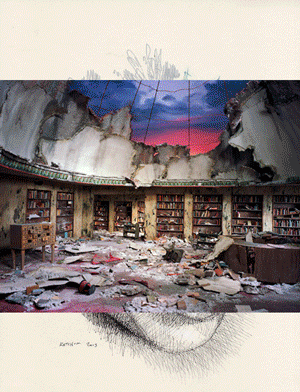There is an abundance of odd-looking, transforming figures in our visual culture. Monsters, mutants, hybrid creatures, robots, cyborgs, ghosts, toys, transgenic beings….turn on the TV and you’re likely to find a series about vampires or superheroes trying to make it in the modern world or cute humanoid creatures advertising anything from fruit juice to insurance. Legions of animated avatars and icons guide our computer use. Home decor shops sell cushion covers or trays that depict people who have bird or deer heads. Incredible monsters try to kill us in games, cartoon sketches represent us in virtual worlds.
All kinds of inanimate objects have magically gained facial features and jerked into action, dancing about for our entertainment in a kind of mass-animism that less than a couple of decades ago, would only be found in the realm of the under 5s’.
These fantastical transformations have also extended into artificial landscapes. Happy animals gambol in colourful textile hills – especially in dairy product and energy company adverts. Plants aren’t excluded from this anthropomorphism either. In fact, nothing is. The most unlikely objects, (fridges, cars, detergent), have leapt and gurned their way onto our retinas.
What’s caused this proliferation? Why have these creatures so friutfully multiplied? There must be several reasons to spawn such hybrid vigor.
Pictures, both moving and still, have become more dominant in society and that this rise is directly linked with the increasing influence of advertising. Given that advertising techniques have developed into methods of sophisticated psychological manipulation, it is worth examining the content of the pictures produced, especially if there are discernable patterns…(It was noticing how animated characters had moved from children’s television to mainstream adverts and then how fantasy just kept popping out of it’s genre, that first prompted me to look further. At first I put this observation down to increasing immaturity in the general populace, but then realised that such a glib and scornful explanation was somewhat inadequate).
Furry figures, or little toys wearing human clothes, or our clothes come to life, or cartoon objects, ease and comfort us in this difficult and stress-filled world. It could be argued that this fantastical aesthetic is the result of a few marketing people deciding what sells more and others following suit, but that doesn’t completely explain the preponderance of anthropomorphism and metamorphosis on our screens and also, (most notably in the genre of magical realism), in print. Ad agencies are responding to the same forces as the rest of us, albeit in a more cynical and calculated way.
We do live in a more difficult and stress-filled world, or at least we perceive that we do. Consumer culture presents us with a bewildering array of selections to make, even about the most mundane product, although the actual differences between products of the same type maybe negligible or non-existent. The branding of these items gives the illusion of difference and therefore the illusion of real choice.
The shift in marketing to become a powerful global force means that not only have marketers become prime image-makers but also that marketing has inveigled its way into cultural production; through sponsorship, through acquisition of cultural sites, through relentless promotion in most forms of media as well as in public spaces and utilities. Given this consumer-capitalist invidious creep into every corner of our lives it is inevitable that brand selection is part of our self-image and that a kind of meta-identity is created, that displays our personality type by the goods and services we acquire.
It may seem like we are choosing things as individual selves and that we see the products we buy as objects, but they’re not. They are lifestyle displays, social status indicators, symbols of virility, statements about age, intelligence, career. They are associated with other brands/goods/services, that flesh out the range of personality qualities. We are conforming to group demographics, a whole set of defining characteristics, I mean products!.
We are aligning ourselves with other people who shop at the same places, , we are part of a certain group that buys tickets to live events, reads one magazine and newspaper a week, buys new footwear twice a year, drinks coffee, has home contents insurance…. the list is infinite. However, it’s the individual, not the group who is targeted in advertising – have you noticed the frequency in which the word ‘you’ is used? ‘Its all about you’, ‘It’s your choice’, ‘have it your way’, et cetera, ad nauseam. Which is a smokescreen to conceal the fact that we’re viewed in the plural by marketers, so many groups of potential profit, so many consumer types to identify and utilise. No wonder we’re constantly assured that, ‘it’s all about you’. It patently isn’t. A more accurate entreaty would be: ‘we see you as a type that could bring us money’, but obviously that wouldn’t work so well.
There are a plethora of products that are very similar to one another yet give off different status signals. It’s a scary world in which perky and perfidious advertisers wield such power and your bathroom cleaning spray gives away your average income, level of social responsibility and gender. So scary and bewildering that I think this is one reason why all those gurning, cute, energetic animated creatures escaped the nursery – to help teach us the ways of product selection and soothe fears we might have about the unknown darkness of corporate manipulation.
to be continued…..
